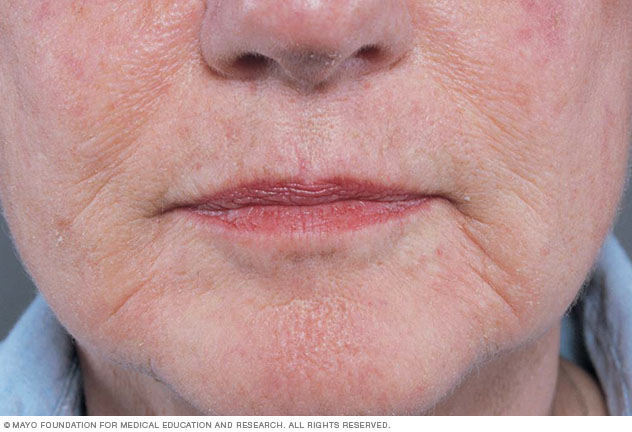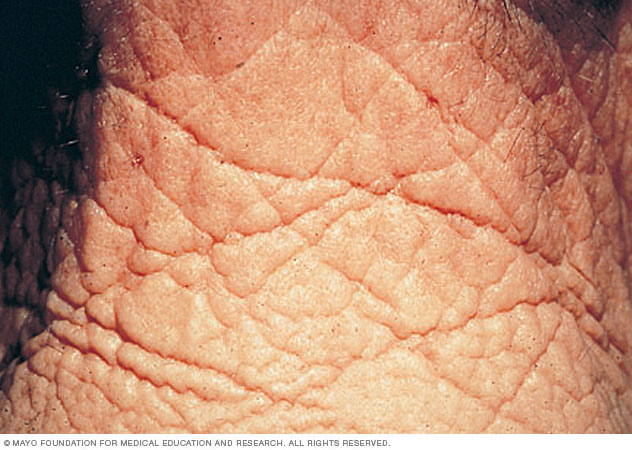Overview
Wrinkles are a natural part of aging. These lines and creases in the skin are most likely to form on skin that's often exposed to the sun, such as the face, neck, hands and forearms. Pollutants and smoking also speed the aging process. Using sunscreen every day and quitting smoking help prevent some wrinkling.
If your wrinkles bother you, many options are available to help smooth them or make them less visible. These include medicines, skin-resurfacing techniques, fillers and surgery.

Symptoms
Wrinkles are the lines and creases that form in your skin. Some wrinkles become deep and may be especially noticeable around the eyes, mouth and neck.
When to see a doctor
If you're concerned about how your skin looks, see a doctor who specializes in the skin. This type of expert is called a dermatologist. Your doctor can assess your skin, help you create a skin care plan and discuss wrinkle treatments.

Causes
Wrinkles are caused by several factors — some you can control, others you can't:
- Age. With aging, the skin naturally becomes less elastic and drier, with less fat and collagen in the deeper layers. This process results in the lines and creases typical of wrinkling. It also causes loose, saggy skin.
- Ultraviolet (UV) radiation. Ultraviolet radiation from sunlight and other sources speeds the skin's aging process, especially in people who tend to sunburn easily. It breaks down the elastin fibers and collagen in skin. Without these supportive connective tissues, the skin loses strength and flexibility.
- Smoking and pollution. Smoking and air pollutants speed the aging process.
- Repeated facial expressions. Facial movements and expressions lead to fine lines and wrinkles. For example, every time you squint, smile and frown, tiny grooves form beneath the surface of the skin. As skin ages, it loses its flexibility and can no longer spring back. These grooves then become features of the face.
- Family history. The genes you inherit play a big part in the look and feel of your skin.
Prevention
Here are some tips for slowing the effects of sun exposure and other causes of wrinkles:
- Protect your skin from UV radiation. Avoid indoor tanning and limit the time you spend in the sun, especially midday. When you're in the sun, wear sun-protective clothing, such as wide-brimmed hats, long-sleeved shirts and sunglasses. Also, use sunscreen every day year-round. Choose a broad-spectrum sunscreen with an SPF of at least 30, even on cloudy days. Apply sunscreen generously. Reapply every two hours, or more often if you're swimming or sweating.
-
Wash your face and moisturize. Dry skin shrivels plump skin cells, which can lead to fine lines and wrinkles. Make it a habit to gently wash your face and moisturize it every day. Moisturizing traps water in the skin.
Moisturizers often have active ingredients that are intended to reduce fine lines and wrinkles. Look for ingredients such as retinol, niacinamide and vitamin C. Many such products also come with a broad-spectrum sunscreen in them. Read the product labels for when and how to apply. Products with retinol or retinoids are not for use when pregnant.
Another option you can buy without a prescription is adapalene (Differin). This is a vitamin A-derived product that can help prevent fine lines and wrinkles.
It may take a few weeks or even months of regular use of the product before you notice any improvement in your skin. Or you may see no change at all. Moisturizers and wrinkle creams that you can buy without a prescription aren't classified as medicine, so they aren't required to undergo scientific research to prove they work. If you're not happy with the results, talk with your healthcare team about moisturizers with prescription-strength anti-wrinkle ingredients, such as retinoids.
- Don't smoke. Even if you've smoked for years or smoke heavily, you can still improve your skin and prevent wrinkles by quitting smoking.
- Eat a healthy diet. There is some evidence that certain vitamins in your diet help protect the skin. More study is needed on the role of nutrition in preventing wrinkles, but it's good to eat plenty of fruits and vegetables.
Diagnosis
A diagnosis of wrinkles involves looking at the skin to assess the lines and creases and what may have caused them. Your doctor also talks with you about your medical history and what's important to you. This discussion helps inform the decision on which treatments might best meet your needs and goals related to results, side effects and recovery time.
Treatment
Several wrinkle treatment options are available to help smooth wrinkles. Your doctor may suggest two or more treatments for the best result.
-
Prescription creams and serums. Your doctor may prescribe an anti-wrinkle product with prescription-strength retinoids. This ingredient is derived from vitamin A. These creams and serums are intended to reduce fine wrinkles and splotches. You may need to use the product for a few weeks or months before you notice improvement. Examples are tretinoin (Renova, Retin-A), tazarotene (Avage, Tazorac) and adapalene (Differin). Differin is now available without a prescription. Retinoids might cause a rash, burning or dryness. Products with retinoids are not for use when pregnant.
Retinoids can make the skin sensitive to the sun, so you may be advised to use the product at bedtime. If you use it during the day, also apply a broad-spectrum sunscreen with an SPF of at least 30. And wear protective clothing, such as a wide-brimmed hat.
-
Botox injections. When injected in small doses into specific muscles, Botox prevents the muscles from moving. This helps skin look smoother.
Botox works well on frown lines between the eyebrows and across the forehead and on crow's-feet. It may take up to seven days to see results. The effect typically lasts a few months. Repeat injections are needed to maintain results.
Possible side effects are headache, droopy eyelids, and pain, swelling, or bruising at the injection site.
-
Chemical peel. A chemical peel may be done as an outpatient procedure. Often numbing is not required. You may be given medicine to put you in a sleep-like state for extensive resurfacing. Then a member of your healthcare team applies a chemical solution to the skin to remove the top layers. The skin that grows back is smoother. Depending on the depth of the peel, you may need several treatments before you see a difference in your skin.
Possible side effects include scarring, infection and changes in skin color of the treated area. People with brown or Black skin have a higher risk of long-term skin color changes.
-
Facial fillers. Facial fillers are products injected into the skin. The fillers plump and smooth lines and creases. Examples are calcium hydroxylapatite (Radiesse), poly-L-lactic acid (Sculptra) and hyaluronic acid (Restylane, Juvederm, others). It may take 1 to 3 sessions to achieve the result you're looking for. After about six months, repeat injections are needed to maintain results.
Possible side effects are inflamed skin, bruising and changes in skin color. These tend to clear up within weeks.
-
Laser resurfacing. Laser resurfacing is a general term for facial rejuvenation procedures that use energy to improve the skin's appearance. These procedures can smooth the skin, but they can't fix sagging skin.
A method called ablative laser resurfacing uses a beam of energy to destroy the outer layer of skin and heat the underlying skin. This stimulates the growth of collagen. As the wound heals, the new collagen leads to smoother, tighter skin. On average, it takes 7 to 10 days to recover.
A method called nonablative laser resurfacing also stimulates collagen growth, but it's a less aggressive approach with more subtle results. It has a shorter recovery time than does the ablative method. Nonablative resurfacing can be a good option for people with moderate wrinkles.
Either of these methods can be done with a fractional laser, which leaves microscopic columns of untreated tissue throughout the treatment area. A procedure done with a fractional laser may have a shorter recovery time and reduce the risk of side effects. You'll likely need more than one treatment session.
Laser resurfacing risks include scarring, infection and skin color changes in the treated area. People with brown or Black skin have a higher risk of long-term skin color changes. If this is a concern, seek out an expert with experience in selecting lasers and settings for a range of skin colors. Before treatment, talk with your doctor about any history of hyperpigmentation or keloid formation.
-
Deoxycholic acid injections. Deoxycholic acid (Kybella) injections are used to treat excess fat under the chin. This condition is often called a double chin. Deoxycholic acid is injected under the skin. It works to dissolve the extra fat cells. The result is a reduction in fullness under the chin. Repeat injections are usually needed.
Possible side effects are swelling, pain, numbness, bruising and hardness under the skin in the treated area.
-
Face-lift and neck lift. Face-lift surgery involves lifting the skin and tightening the underlying muscle and tissues. The goal is to improve the look of the jawline, neck and lower face. A neck lift is often done at the same time. A face-lift won't correct fine wrinkles, sun damage, uneven skin color, or creases around the nose and upper lip.
These surgeries may be done in a hospital or an outpatient surgical facility. Before the procedure, you're given an injection to numb the treatment area, medicine to relax you or medicine to put you in a sleep-like state.
Risks include bleeding, infection and a collection of blood under the skin, which is called a hematoma. Healing times can be lengthy. Bruising and swelling won't clear up for several weeks after surgery.
Face-lift and neck lift results aren't permanent. You may choose to undergo another surgery several years later.
Products, procedures and surgeries to enhance your appearance usually aren't covered by insurance. Also, many of these treatments can have side effects, so be sure to discuss them with your doctor. Ask how many times they've done the treatment you're considering and if they have experience in treating people with your skin color.
Preparing for an appointment
When you make an appointment with a dermatologist, it's a good idea to prepare for your appointment by making a list of questions you want answered. For wrinkles, some basic questions to ask include:
- What is the best course of action?
- What are my treatment options and the pros and cons of each?
- What do the treatments cost? Does medical insurance usually cover these treatments?
- What results can I expect?
- How often will I need to repeat the treatment?
- What kind of follow-up, if any, will I have?
Don't hesitate to ask any other questions you have.
What to expect from your doctor
You may be asked a number of questions, including:
- What products, such as cleansers and moisturizers, do you use on your skin?
- Do you use sunscreen?
- Did you expose your skin to sun when you were younger?
- Have you used tanning beds in the past? Do you use them now?
- Do you smoke or have you ever smoked?
© 1998-2025 Mayo Foundation for Medical Education and Research (MFMER). All rights reserved. Terms of Use


